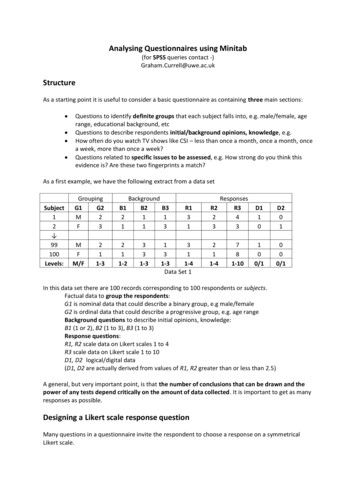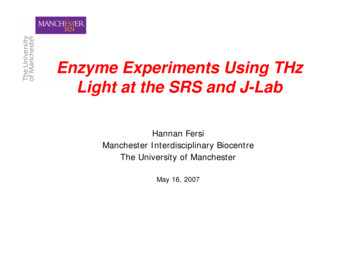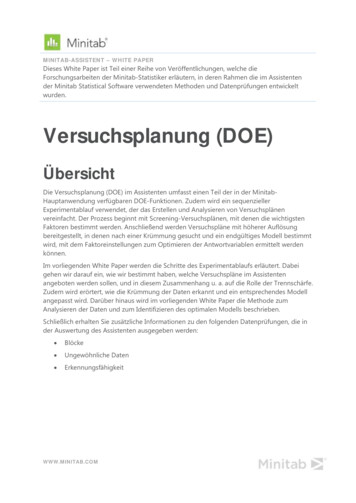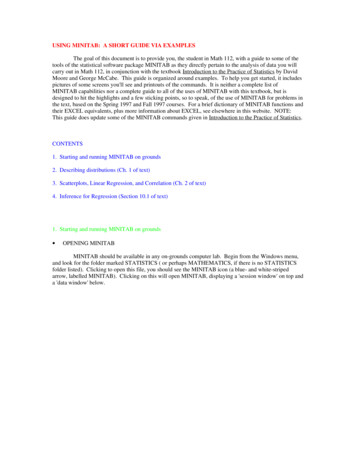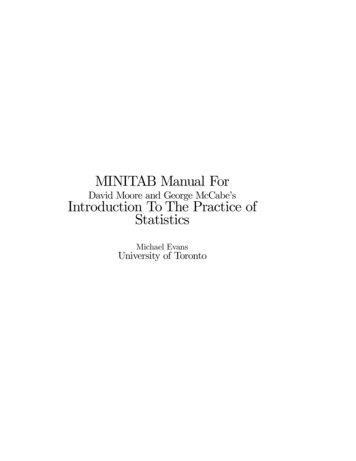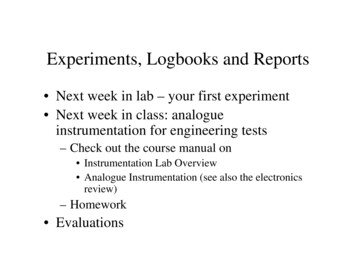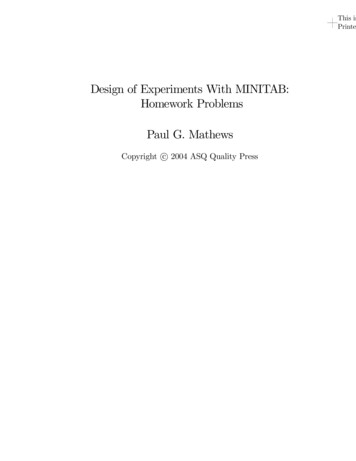
Transcription
This isPrinteDesign of Experiments With MINITAB:Homework ProblemsPaul G. MathewsCopyright c 2004 ASQ Quality Press
ii
This isPrinteContents1 Graphical Presentation of Data12 Descriptive Statistics53 Inferential Statistics94 DOE Language and Concepts175 Experiments for One-Way Classi cations216 Experiments for Multi-Way Classi cations257 Advanced ANOVA Topics298 Linear Regression339 Two-Level Factorial Experiments3910 Fractional Factorial Experiments4511 Response Surface Experiments49
ivContents
This isPrintePrefaceThe following problems are intended as homework or self-study problems to supplement Designof Experiments with MINITAB by Paul Mathews. The problems are organized by chapter andare intended to be solved using a calculator and statistical tables or with MINITAB or someother suitable statistical software program. The data sets given in the problem statements arealready loaded into Excel and can be easily copied and pasted into MINITAB to avoid the taskand risk of manual data entry. Some of the problems refer to simulations that are implementedas MINITAB macros and in Microsoft Excel spreadsheets. Before you can run the Excel macros,you will have to change Excel’s Tools Macros Security setting to medium and restart Excel.The problems o ered here are rather minimal because I feel that any student or instructorshould take the initiative to design and build his or her own experiments. You’ll learn much morefrom those exercises than you will from doing any or all of the problems presented here. Considerdoing some of the simple experiments described in the Classroom Experiments and Labs folderon the CD ROM - they’re much harder than they look!Many of the problems in this document refer to or make use of other documents or lescontained on the CD ROM. With respect to homework problems, the contents of the di erentfolders on the CD ROM are:Homework Problems - This folder contains this le (Homework Problems.pdf ) of homeworkproblems, Excel les with the corresponding data sets, and other related documents and les.Classroom Exercises and Labs - This folder contains simple demonstrations and lab exercisesthat can be performed in a classroom, lab, kitchen, or garage.Example Problem Data - This folder contains Excel les with the data used in the exampleproblems in the textbook.Excel Design Files - This folder contains a small collection of Excel les with some ofthe most commonly used experiment designs. Each experiment design worksheet has anintegrated simulation macro that creates data for a ctional response. All of the design leswith the same number of variables contain the same simulation function so you can compare
viContentsthe performance of di erent experiment designs e ectively within the same process. Thesesimulations, which are referred to as sim3, sim4, . are used extensively in homeworkproblems.MINITAB 14 Macros - This is a collection of design, analysis, and simulation macros. Thereare many more macros here than are described in the textbook. Open the ReadMe.txt lein Notepad to view a complete catalog and short description of these macros. These macrosshould be copied to the Macros folder of your Program Files MINITAB 14 folder so thatMINITAB can nd them easily.MINITAB Design Files - This folder contains a collection of MINITAB worksheets of somecommon experiment designs. These les are designed to be used with some older MINITABexec simulations (e.g. sim3.mtb) and have been substantially superseded by MINITAB’sStat DOE tools and the Excel design les.
This isPrinte1Graphical Presentation of Data1. Use MINITAB to construct a histogram, dotplot, stem-and-leaf plot, and boxplot of thefollowing data:{810, 765, 860, 825, 795, 785, 810, 790, 785, 815, 800, 790}Add your name and the date to the graphs and the relevant Session window output andprint them. Save your work in a MINITAB project le.2. Use MINITAB’s random function to generate a pseudo-random data set of 50 normallydistributed values with 200 and 30. To run the command from the commandprompt use:mtb random 50 c1;subc normal 200 30.or use the Calc Random Data Normal menu and enter the appropriate values inthe window. Create the histogram, dotplot, stem-and-leaf plot, and boxplot for these data.Make hardcopies of the worksheet, Session window, and graphs and save your work in aproject le.3. Repeat Problem 1.2 for another data set of 200 normally distributed random values with 3:4 and 0:6 by:(a) Copying the appropriate commands from the Session window of Problem 1.2, editingthem, and pasting them to the command prompt.(b) Selecting the appropriate commands from the History window and running them fromthe command line editor.(c) Saving the appropriate commands from the History window to a MINITAB .mtb macro le, editing the le, and running the macro.4. Use MINITAB to generate a random sample of size n 200 from a normal population with 200 and 10. Create a histogram of the data with a superimposed normal curve and
21. Graphical Presentation of Datalabel the axes Frequency and Measurement Value. Force the minimum and maximum valuesof the measurement scale to be 160 and 240, respectively, and force ticks and labels at 160,170, ., 240. Use arrows and tags to indicate the classes with the largest and smallest values.Title the graph Histogram Example in MINITAB using 18 point Arial font and make thetitle t on one line.5. Enter the following exam score data into three columns of a MINITAB worksheet anduse MINITAB to construct boxplots of the exam scores by class. Use the plots to identifypossible di erences in the location, dispersion, and shape between the three 739277899074809071708575806. Stack the exam score data from Problem 1.5 into a single column of the MINITAB worksheetusing the Data Stack Columns menu (or the stack command). Then recreate theboxplots of the exam scores using the stacked data.7. Many DOE problems involve a response that is observed under di erent settings of severalcontrol variables. Despite the complexity of these problems, it is still important to showthe relationship between the response and the control variables graphically. MINITAB hasthe ability to create matrix plots and multi-vari charts for problems involving two or morecontrol variables.The useful lifetime of zinc-carbon batteries depends on the load that they drive, the dutycycle, and their lowest useful voltage called the cuto voltage. The table below shows theoperating lifetime in hours for standard zinc-carbon D-cells for loads from 8 to 100 ,100% and 17% duty cycles, and 0:8 to 1:2V cuto voltage (M. Kaufman and Seidman, A.Handbook of Electronics Calculations for Engineers and Technicians, 2nd Edition, McGrawHill Book Company, 1988, p. 11-10).Duty Cycle (%)100100100171717Load ( )8.0251008.025100Cuto Voltage (V )0.8 0.9 1.0 1.1 1.21711 7.2 6.0 3.27551433828430 365 320 290 240201715 9.2 5.19889817060430 380 360 345 310(a) Use MINITAB’s Graph Matrix Plot command to construct the matrix plot of thelifetime in hours, cuto voltage, duty cycle, and load. Use the matrix plot to try toexplain the relationship between the di erent variables.(b) Use MINITAB’s Stat Quality Tools Multi-Vari Chart command to create amulti-vari chart of the battery lifetime as a function of the control variables. Use themulti-vari chart to explain how the lifetime depends on the other variables. You mayhave to consider several di erent charts before you nd one that is easy to interpret.
1. Graphical Presentation of Data38. Match each type of graphical presentation to its description.AnswerPresentationscatter plotdot plotstem-and-leaf plothistogrammulti-vari chartbar chartbox-and-whisker plotPareto chart(a) Often constructed by separating the least from the most signi cant digits of the data.(b) Used to prioritize di erent types of defects.(c) Capable of displaying a response as a function of two or more variables, each with alimited number of levels.(d) Uses bar lengths proportional to class frequencies and classes of equal width.(e) A plot of one quantitative variable against another to demonstrate or test for correlation between them.(f) Constructed from ve statistics determined from the sample data set.(g) Consists of points plotted along a number line and stacked where there are duplicates.(h) Uses bar lengths proportional to class frequencies but classes are qualitative.
41. Graphical Presentation of Data
This isPrinte2Descriptive Statistics1. For the following data set:f43; 46; 54; 51; 45; 49; 42; 52; 50guse pencil and paper or a calculator to nd:(a) the median(b) the mean(c) the range(d) thei(e) the standard deviation using the de ning formula(f) the standard deviation using the calculating formula(g) an estimate forusing the range2. Use a calculator to determine the sample mean, standard deviation, and range of thefollowing data set:{810, 765, 860, 825, 795, 785, 810, 790, 785, 815, 800, 790}Use the range to estimate the population standard deviation and compare your new estimateto the sample standard deviation.3. Use MINITAB to check your answers from Problem 2.2.4. Use MINITAB’s random function (or the Calc Random Data Normal menu) tocreate a random standard normal data set of 1000 samples, all of size n 5. Calculate theaverage range R from the 1000 ranges and use it to show that d2 ' R ' 2:326 for n 5:5. Repeat Problem 2.4 to demonstrate that d2 ' 3:078 for n 10.6. Use Table A.2 to nd the following normal probabilities:
62. Descriptive Statistics(a)(b)(c)( 1 z 2:44)( 1 z 1:82)(1:82 z 2:44)(d)( 1:82 z 2:44)(e)(2:4 x 2:9;(f)(0:043 x 0:053; 2:5; 0:8) 0:050; 0:003)7. Use MINITAB to con rm your answers from Problem 2.6.8. A quality characteristic from a process is normally distributed with 0:580 and 0:008. Find symmetric upper and lower speci cation limits centered at for x such that99% of the parts from the process will fall within the speci cation limits.9. The speci cation limits for a normally distributed process are U SL LSL 34(a) If the mean of the process is 33:7 and the standard deviation isfraction of the product that is in spec.2. 0:4 nd the(b) Find the new fraction defective from Part a if the process mean is centered within thespeci cation limits.10. Use MINITAB to plot the normal curve that has 0:640 and 0:020. Add verticalreference lines to the plot at the speci cation limits LSL 0:590 and U SL 0:700 and nd the probability that x falls in this interval. Add this information to the plot.11. A pizza can have ten di erent toppings and each topping can only be chosen once.(a) How many di erent pizzas can be made if the order of the toppings does not matter?(b) How many one-topping pizzas can be made?(c) How many two-topping pizzas can be made if the order of the toppings is important?(d) How many two-topping pizzas can be made if the order of the toppings is not important? What is the relationship between this answer and that from Part c?(e) Determine how many pizzas with 0, 1, ., 10 toppings can be made and compare thetotal to your answer in Part a.12. How many tests between pairs of treatment means have to be considered if there are sixdi erent treatments? Write out the list of paired comparisons to con rm your answer.13. An experiment has two levels of each of four variables and all possible con gurations of thevariables are built. How many main e ects, two-factor interactions, three-factor interactions,and four-factor interactions are there? How does the sum of these combinations relate tothe number of levels and variables?14. An experiment is to be performed to study three variables. The rst variable will havethree levels, the second will have two, and the third will have ve. How many runs mustthe experiment have to consider every possible combination of variable levels?
2. Descriptive Statistics15. Match each statistic to its description:Answer StatisticRIQRxxesxminxmaxQ1Q3(a) The middle value in the ordered data set.(b) An interval that contains one half of the observations.(c) The largest value of the data set.(d) The 75th percentile.(e) The value, determined from the data set, above which 75% of the observations fall.(f) An estimate of variation based on xmin and xmax .(g) A measure of variation that takes into account all of the data values.(h) The smallest value of the data set.(i) A measure of location that takes into account all of the data values.7
82. Descriptive Statistics
This isPrinte3Inferential Statistics1. A sample of n 8 engines of a new design had an average peak shaft horsepower of x 186hp. The distribution of shaft horsepower is known to be normal with standard deviationof 6hp. Write the 95% con dence interval for the population peak shaft horsepowerand test the claim that the mean horsepower exceeds its target value of 180hp.2. The performance of ROM chips is very sensitive to the ring temperature at a critical stepin their manufacture. The ring temperature is speci ed to be 500C. A sample of n 35temperature readings gave an average temperature of x 497C and standard deviation ofs 6C.(a) Is there su cient evidence to indicate that the furnace temperature is not 500C? Usea two-tailed test with 0:05. What is the p value of the test?(b) If there is evidence that H0 : 500 must be rejected, then construct the 95%con dence interval for the true population mean temperature.3. Each boxplot in Figure 3.1 was constructed from a random sample of size n 200.(a) Interpret the boxplots in terms of location, dispersion, and shape.(b) Sketch the corresponding histograms.(c) Sketch the corresponding normal probability plots.4. Hand plot the following three data sets on normal probability paper to determine if theirpopulations are normally distributed. (You can create normal paper for manual plottingwith the custom MINITAB macro normalpaper.mac.)(a) f83; 79; 70
exec simulations (e.g. sim3.mtb) and have been substantially superseded by MINITAB s Stat DOE tools and the Excel design –les. This is page 1 Printer: Opaque this 1 Graphical Presentation of Data 1. Use MINITAB to construct a histogram, dotplot, stem-and-leaf plot, and boxplot of the following data: {810, 765, 860, 825, 795, 785, 810, 790, 785, 815, 800, 790} Add your name and the date to .File Size: 331KBPage Count: 59


